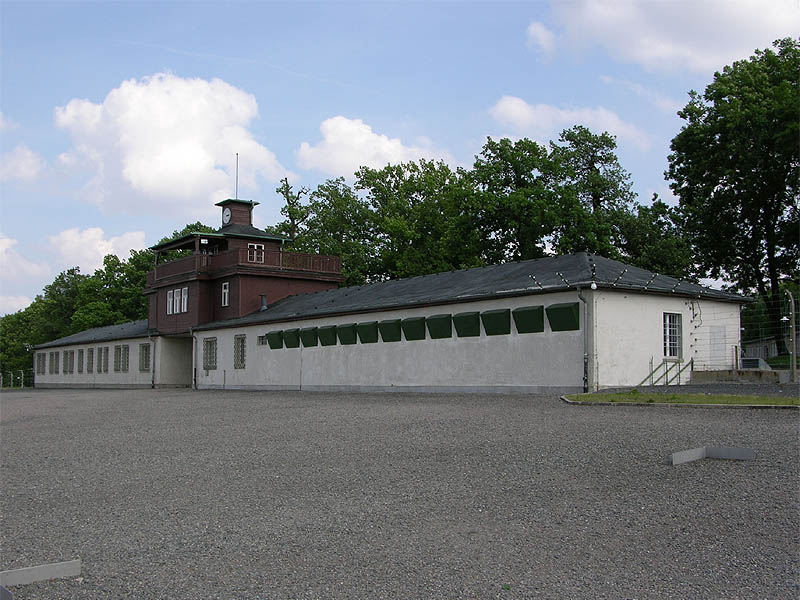KZ Buchenwald

The camp consisted of three separate parts. The first one, called the preventive arrest camp, covered 40 hectares, with 34 wooden barracks and 16 two-storey stone barracks. A high barbed-wire fence surrounded the area and additionally a live wire of several hundred volts, with 22 watchtowers equipped with machine guns. In addition to a 15,000-m² roll call square and a camp for Jews, there was also a quarantine barrack for those unable to work; from 1943 onwards, there was a brothel there, where women from the Ravensbrück concentration camp were forced into prostitution.
In another part of the camp there were administration facilities, SS barracks, Waffen-SS base and training centre, isolation barracks for high-ranking internees (such as e.g. Fritz Thyssen and Edouard Daladier), resting places for SS members and their families, and another brothel for Ukrainian guards, where Polish women - prisoners of the Ravensbrück camp - were brought. In 1941, the 55-meter stables were reconstructed, in which - under the guise of medical examinations - mass murders were committed by a shot in the neck. Over 8,000 Soviet prisoners of war were killed in this way.
In the third part, there were workplaces: a quarry, where the hardest work was done and where prisoners were shot when suspected of wanting to escape. Moreover, 4,500 people worked at the Gustloff-Werk II armaments plant and 1,400 people at Deutsche Ausrüstungswerke. Additionally, there were 136 sub-camps and work units operating, where prisoners were used for servile labour.
On the 11th of April 1945, the American army liberated the camp, although a prisoner resistance movement operated even sooner. After the Soviet occupation took over the area, the former camp was turned into a prison for fascists and war criminals, but also for potential enemies of the new socialist system. By 1950, another 7,000 people died there. Shortly after the war, decision was made on creating a memorial site there, which was renovated after German reunification.
The numerous victims of the camp also included some participants of the Warsaw Uprising:
BENEDYK TADEUSZ Lieutenant of Artillery, Reservist, a.k.a. "Zahata"
* 4.12.1916 Kaczanówka
† 1945
BŁASZCZAK BOLESŁAW (in the archives of the Warsaw Uprising Museum as Bolesław Błaszczyk)
* 2.8.1895 Warsaw
† 5.4.1945
CELEJEWSKI BOLESŁAW Rifleman, a.k.a. "Zielony"
* 31.12.1921 Warsaw
† 18.4.1945
DOMAŃSKI JERZY STANISŁAW a.k.a. "Stanisław Kochański"
* 4.11.1902 Warsaw
† 8.4.1945
FEDORCZYK HIERONIM a.k.a. "Zagłoba"
* 29.9.1906 Łódź
† 29.1.1945
FRONTCZAK STEFAN a.k.a. "Orzeł"
GRABARCZYK JAKÓB
* 1.8.1903 Łódź
† 15.3.1945
GRZYBOWSKI LEON Rifleman, a.k.a. "Loniek"
JAGUSIAK JANUSZ Rifleman, a.k.a. "Bohun"
KAMIŃSK STANISŁAW a.k.a. "Ryś"
* 8.5.1906 Warsaw
† in 1945
KOSIOREK JAN OFICER
† 5.1.1945
KOSTRZEWA ANTONI
* 20.7.1890
† 8.11.1944
KOWALCZYK STANISŁAW
* 11.8.1898 Stara Wieś
† 28.11.1944
LATOSZEK ANTONI a.k.a. "Kowalski"
* 29.11.1905 Gorzkiewki
† 9.5.1945
MACIERAKOWSKI ANDRZEJ Runner, a.k.a. "Klon", "Tajfun"
* 1929
NALEPA STEFAN Rifleman, a.k.a. "Cieśla"
* 1921
† 1945
RAUSIŃSKI STEFAN a.k.a. "Twardy", "Jakób"
* 25.8.1906 Warsaw
† 20.2.1945
RYNKIEWICZ ANTONI a.k.a. "Elew"
* 29.4.1916 Vilnius
† 9.2.1945
SALACH STANISŁAW Lance Corporal Rifles, a.k.a. "Kobus"
* 1922
WOHLFART KAZIMIERZ Cpl., Cadet Officer, a.k.a. "Korecki"
* 5.3.1921 Warsaw
† 27.3.1945
WOJDA ANTONI a.k.a. "Wikcia"
† 2.3.1945